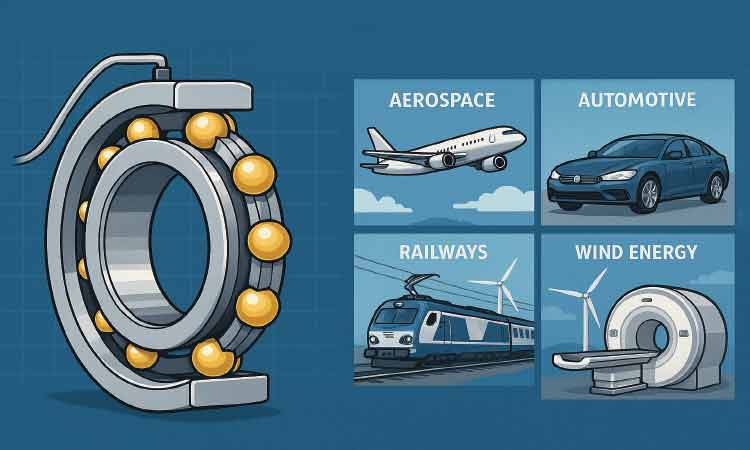Bearings are the unsung heroes of modern machinery, playing a pivotal role in ensuring smooth operations in industries such as aerospace, automotive, railways, wind energy, and medical equipment. With advancements in technology, there has been an increasing demand for high-speed bearings with integrated sensors to enhance performance, reliability, and predictive maintenance. These innovations are crucial for critical applications where failure can have significant consequences.
Evolution of High-Speed Bearings
Traditional bearings have evolved significantly over the years. Early bearing designs focused on reducing friction and wear, but modern requirements necessitate bearings that can operate at extremely high speeds while maintaining efficiency and durability. The development of high-speed bearings has been driven by advancements in material science, lubrication technology, and precision manufacturing.
Material Innovations
One of the key factors influencing high-speed bearing performance is the choice of materials. Conventional steel bearings are being replaced or supplemented with advanced materials such as:
- Ceramic Bearings:
Hybrid ceramic bearings, which use silicon nitride (Si₃N₄) rolling elements with steel races, exhibit lower density, higher stiffness, and reduced thermal expansion, making them ideal for high-speed applications. - Advanced Coatings:
DLC (Diamond-Like Carbon) and TiAlN (Titanium Aluminum Nitride) coatings enhance wear resistance and reduce friction, extending bearing life. - Polymer Bearings:
These are used in specific applications where lightweight and corrosion resistance are crucial.
Lubrication and Thermal Management
As speeds increase, lubrication becomes a critical factor. Traditional grease lubrication may not suffice for ultra-high-speed applications, leading to the development of:
- Air-Oil Lubrication Systems:
These provide a fine mist of oil, ensuring adequate lubrication without excess heat buildup. - Self-Lubricating Bearings:
Some advanced bearings use solid lubricants or nano-lubrication technologies to minimize wear. - Active Cooling Mechanisms:
Integrated cooling channels help dissipate heat, preventing premature failure.
Sensor Integration in Bearings
With the advent of Industry 4.0, sensor technology is being increasingly integrated into bearings, enabling real-time monitoring of various parameters such as temperature, vibration, speed, and load.
Types of Sensors Used
Modern sensor-integrated bearings incorporate various types of sensors, including:
- Temperature Sensors:
Monitor excessive heat generation, which can be an early sign of failure. - Vibration Sensors (MEMS Accelerometers):
Detect misalignment, imbalance, or early-stage bearing defects. - Load Sensors (Piezoelectric & Strain Gauges):
Measure real-time loads, optimizing performance in dynamically changing environments. - Speed and Position Sensors:
Essential in applications like high-speed spindles and aerospace systems to ensure precise motion control.
Applications of Sensor-Integrated Bearings
Aerospace and Aviation:
In jet engines and landing gear systems, real-time health monitoring of bearings is crucial to avoid catastrophic failures.
Automotive Industry:
In electric vehicles (EVs), sensor-based bearings help optimize energy efficiency and predict maintenance needs.
Wind Energy:
Wind turbines require sensor-equipped bearings for condition monitoring and predictive maintenance, ensuring long-term reliability.
Medical Equipment:
MRI machines and robotic surgical systems rely on ultra-precision bearings with integrated sensors for smooth and error-free operation.
Industrial Machinery:
High-speed CNC spindles and robotic arms benefit from condition monitoring to enhance precision and uptime.
Challenges and Future Prospects
Despite the advantages, the development and adoption of high-speed, sensor-integrated bearings face several challenges:
- Miniaturization of Sensors: Embedding sensors within compact bearings without compromising performance remains a technical hurdle.
- Data Processing and Connectivity: The vast amount of data generated requires advanced analytics and IoT integration for meaningful insights.
- Cost Considerations: High-end materials and embedded electronics increase production costs, necessitating cost-effective solutions.
- Durability and Power Supply: Ensuring the longevity of sensors in harsh environments and providing reliable power sources, such as energy harvesting techniques, is an ongoing challenge.
Looking ahead, the future of high-speed and sensor-integrated bearings will be driven by further advancements in AI-based predictive maintenance, wireless sensor technology, and self-healing materials. As these technologies mature, they will redefine reliability and efficiency in critical industrial applications, ensuring safety and performance at unprecedented levels.
Conclusion
The development of high-speed and sensor-integrated bearings represents a major leap in engineering innovation, catering to the growing demands of critical applications. By combining advanced materials, smart lubrication systems, and real-time monitoring capabilities, these bearings are revolutionizing industries that rely on precision, speed, and reliability. As technology continues to evolve, these intelligent bearing systems will play an increasingly vital role in shaping the future of modern machinery & industrial automation.



